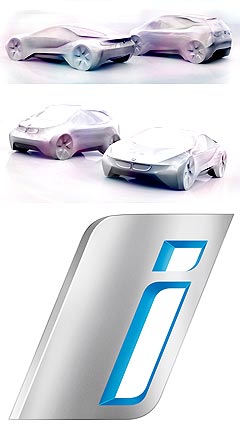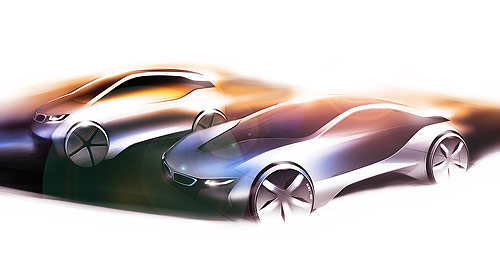Future models - BMW - i3BMW goes electric with iiBrand: New EV sub-brand for BMW revealed. All-electric city car and plug-in hybrid super coupe set to launch BMW i sub-brand22 Feb 2011 BMW has unwrapped its new electric vehicle sub-brand – BMW i – to develop and market a range of full-electric and plug-in range extender hybrid vehicles around the globe from 2013. However, Australia is expected to have to cool its heels a bit longer for the arrival of the first two models – the BMW i3 all-electric city car that was previously known as the Megacity Vehicle concept, and the BMW i8 plug-in hybrid super-coupe based on the Vision EfficientDynamics concept. BMW Australia head of corporate communications Piers Scott confirmed that the sub-brand would be rolled out in this country, but cautioned that it was unlikely to happen in 2013. “The working title for the i3 is the Megacity Vehicle, and its primary application and intended market is major, densely populated metropolises,” he said. “So, I suggest that’s where the focus will be. “It is a worldwide sub-brand, but in terms of details of the arrival of the new i3 and i8 into Australia, it is far too early to say. “But it is certainly a range of products that we are very excited about bringing to Australia whenever that time may be.”  The new BMW i models will not only herald the arrival of the electric age at the Munich-based company but also a new purpose-built vehicle architecture comprising an aluminium chassis housing the electric drivetrain and batteries, topped by a carbon-fibre-reinforced plastic (CFRP) body – a first for a mass manufacturer. The new BMW i models will not only herald the arrival of the electric age at the Munich-based company but also a new purpose-built vehicle architecture comprising an aluminium chassis housing the electric drivetrain and batteries, topped by a carbon-fibre-reinforced plastic (CFRP) body – a first for a mass manufacturer.Announcing the new sub-brand in Germany overnight, BMW said the move represented a new movement in premium mobility. BMW AG board member for sales and marketing Ian Robertson said: “It’s a new day in our industry a new era for individual mobility. This is BMW i – Born Electric.” Mr Robertson said the BMW i range of vehicles and services was the result of ‘project i’, a BMW Group think-tank that has been exploring sustainable mobility solutions for the company since 2007. The move into electric vehicles was foreshadowed by BMW 12 months ago, with the confirmation that the car codenamed Megacity Vehicle would go into production for sale through a separate sub-brand. Although BMW has not released details of the powertrain and performance figures for either the i3 or larger i8, it has confirmed that both will eschew conventional steel monocoque engineering of other BMWs in favour of its revolutionary LifeDrive architectures that comprises two separate modules – one in aluminium and the other in composite materials. At the bottom is the ‘Drive’ module that combines the battery and electric drive system with structural and crash components within a single chassis construction, while the ‘Life’ module that rides on it comprises what BMW says is a lightweight yet high-strength four-seat passenger compartment made from CFRP that is said to be as strong as steel but 50 per cent lighter than plastic. The weight savings in the body – the result of a joint venture with Seattle-based SGL Carbon – are designed to offset the extra burden of the battery pack to help retain BMW’s trademark sports performance. The BMW i3 will be the company’s first series-produced electric vehicle, assembled alongside the i8 in BMW’s Leipzig plant that will get a €400 million ($A542m) makeover to handle the new body assembly system. BMW has confirmed that both vehicles will share the same electric motors, power electronics and high-voltage lithium-ion batteries, but the mid-engined 2+2 i8 coupe will gain an internal combustion engine to charge the batteries for greater range. If that engine is true to the Vision EfficientDynamics concept, it will be a 120kW alloy-block 1.5-litre three-cylinder common-rail turbocharged diesel that will also make its way into the 1 Series from 2014. The concept car’s drivetrain also had two electric motors – a large 82kW unit driving the front wheels, and a smaller 39kW motor sitting alongside the diesel engine and driving the rear wheels via a six-speed dual-clutch gearbox. Electronic controls apportioned drive to all four wheels, with the prototype boasting a combined 241kW – sufficient to propel it from zero to100km/h in just 4.8 seconds. The lithium-ion batteries could be recharged at a conventional power socket in two and a half hours, providing electric propulsion for up to 50km or up to 700km when the diesel engine kicked in. Other models are expected to be added to the BMW i range, with the Bavarian company registering a whole range of ‘i’ model names, from i1 to i9. Project i has also spawned a New York-based venture capital company, BMW i Ventures, with a bankroll of up to $US100 million to expand the range of products and services offered by BMW i by taking stakes in innovative service providers. Its first acquisition is New York company My City Way which produces phone apps to provide information on public transportation, parking availability and local entertainment for more than 40 cities in the United States. “Another 40 cities will be part of the global rollout, including Munich, of course,” Mr Robertson said. As well, the BMW i sub-brand will handle the development of what the company describes as “car-independent mobility services”, focusing on areas as diverse as improving use of parking spaces, intelligent navigation systems with local information, intermodal route planning and premium car-sharing.  Read more10th of August 2010  Boutique sales for BMW’s MegacityDon’t hold your breath for BMW’s first EV in AustraliaAll future models Alfa Romeo Alfa Romeo Abarth Abarth Audi Audi Aston Martin Aston Martin BMW BMW Bentley Bentley Chrysler Chrysler Chevrolet Chevrolet Dodge Dodge Citroen Citroen Ferrari Ferrari DS DS Ford Ford Fiat Fiat FPV FPV Foton Foton Haval Haval Great Wall Great Wall Honda Honda Holden Holden Hyundai Hyundai HSV HSV Isuzu Isuzu Infiniti Infiniti Jeep Jeep Jaguar Jaguar Lamborghini Lamborghini Kia Kia Lexus Lexus Land Rover Land Rover Mazda Mazda Maserati Maserati Mercedes-Benz Mercedes-Benz McLaren McLaren Mini Mini Nissan Nissan Mitsubishi Mitsubishi Peugeot Peugeot Opel Opel Proton Proton Porsche Porsche Renault Renault Ram Ram Saab Saab Rolls-Royce Rolls-Royce Smart Smart Skoda Skoda Subaru Subaru SsangYong SsangYong Tesla Tesla Suzuki Suzuki Toyota Toyota Volvo Volvoi3 pricing
Motor industry news |
Click to shareBMW modelsResearch BMW All future models Alfa Romeo Alfa Romeo Abarth Abarth Audi Audi Aston Martin Aston Martin BMW BMW Bentley Bentley Chrysler Chrysler Chevrolet Chevrolet Dodge Dodge Citroen Citroen Ferrari Ferrari DS DS Ford Ford Fiat Fiat FPV FPV Foton Foton Haval Haval Great Wall Great Wall Honda Honda Holden Holden Hyundai Hyundai HSV HSV Isuzu Isuzu Infiniti Infiniti Jeep Jeep Jaguar Jaguar Lamborghini Lamborghini Kia Kia Lexus Lexus Land Rover Land Rover Mazda Mazda Maserati Maserati Mercedes-Benz Mercedes-Benz McLaren McLaren Mini Mini Nissan Nissan Mitsubishi Mitsubishi Peugeot Peugeot Opel Opel Proton Proton Porsche Porsche Renault Renault Ram Ram Saab Saab Rolls-Royce Rolls-Royce Smart Smart Skoda Skoda Subaru Subaru SsangYong SsangYong Tesla Tesla Suzuki Suzuki Toyota Toyota Volvo Volvoi3 pricing
Motor industry news |
















Facebook Twitter Instagram